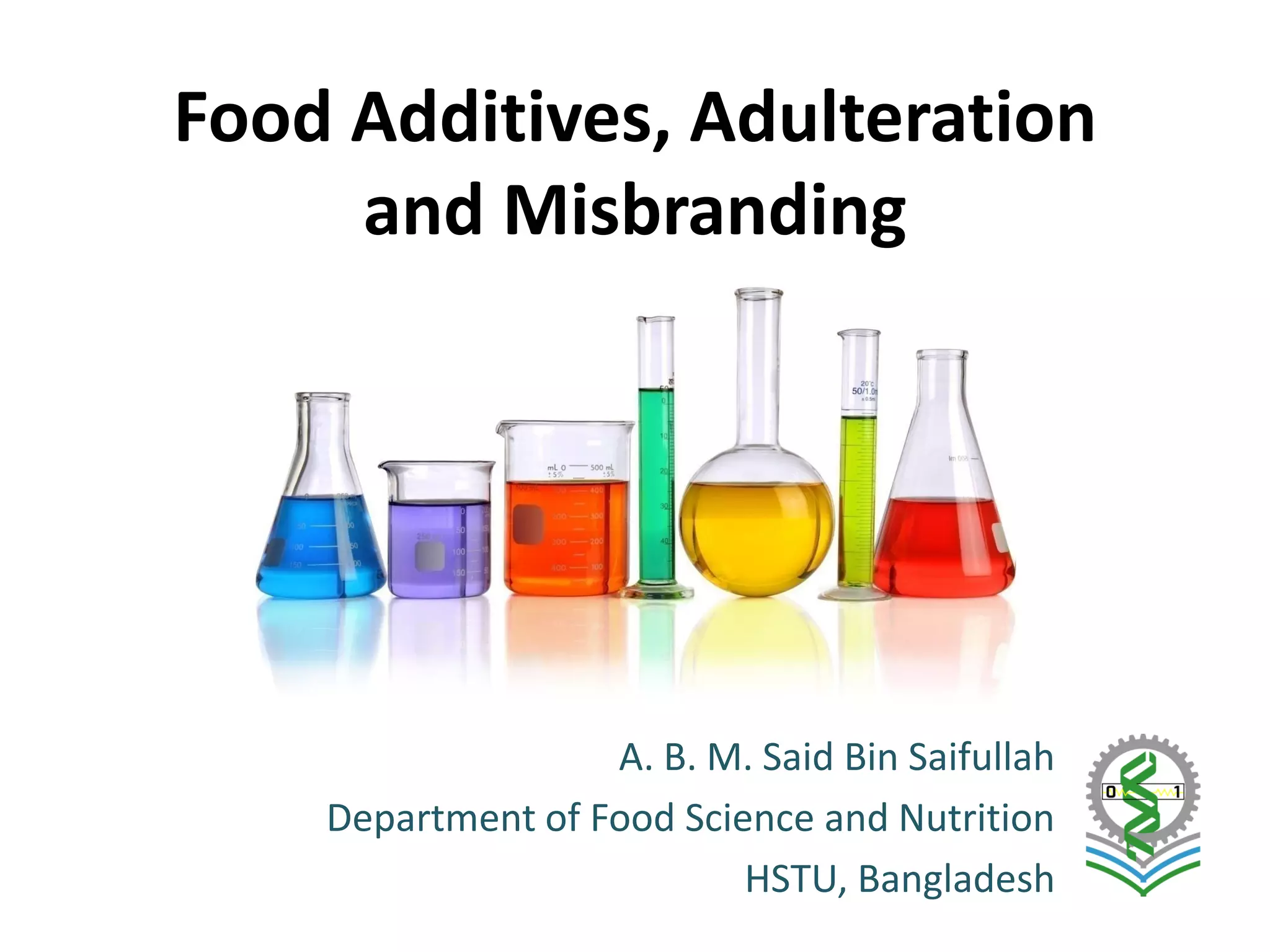
Understanding Common Adulterants: From Chemical Additives to Contaminants"
Food adulteration is a pervasive issue that has plagued the food industry for centuries. It involves the addition of inferior, harmful, or fraudulent substances to food products, often to increase profits at the expense of consumer health and safety. This practice not only compromises the quality and nutritional value of food but also poses significant risks to public health. In this comprehensive essay, we will explore the various aspects of food adulteration, its history, common adulterants, detection methods legal regulations, and the impact it has on society.
Food is a fundamental necessity for human survival, and the quality and safety of the food we consume are of paramount importance. Food adulteration is the intentional act of debasing the quality of food by adding impurities or diluting it with substandard or harmful substances. It is a multifaceted problem with far-reaching implications for public health, consumer trust, and the economy. Food adulteration is not a recent phenomenon but has been a concern for centuries. In ancient times, there were instances of traders mixing chalk powder with flour, watering down wine, or adulterating spices with cheaper substances. The motivation behind these practices was often financial gain, as adulteration allowed merchants to sell lower-cost products while still charging higher prices. In the 19th century, food adulteration became a major issue in Europe and North America. A series of food scandals, including the use of poisonous chemicals in food processing, led to public outcry and the enactment of food safety laws. The Food Adulteration Act of 1872 in the United Kingdom was one of the earliest legislative attempts to combat
There are numerous adulterants that can be added to food products. These include but are not limited to:
Indeed, food adulteration can involve various substances that are added intentionally to food products to deceive consumers or cut production costs. Some of the common adulterants include:
1. Chemical Additives
– Artificial Colors: Unauthorized synthetic dyes added to enhance or change the color of food products.
– Artificial Sweeteners: Substitutes like saccharin or aspartame added in place of natural sugars.
– Preservatives: Chemicals like formaldehyde, benzoic acid, or sulfites added to extend shelf life.
– Antibiotics and Growth Hormones: Added to livestock feed to promote growth and prevent diseases.
2. Contaminants from Pesticides and Herbicides:
– Residues of pesticides or herbicides used in agriculture that surpass acceptable limits and end up in food products.
3. Adulteration with Inferior Substances:
– Water or Other Liquids: Dilution of beverages or milk with water to increase volume.
– Cheaper Oils: Mixing high-quality oils with cheaper, lower-grade oils.
– Starch or Talcum Powder: Added to spices or powdered foods to increase weight.
– Chalk Powder: Added to milk or flour to increase volume and weight.
– Sawdust or Husk: Added to spices, coffee, or tea to increase bulk.
– Brick Powder: Mixed with chili powder to give it a bright red color.
4. Allergens and Non-Food Items:
– Allergens: Addition of undeclared allergens like nuts, gluten, or soy that can pose severe health risks to allergic individuals.
– Non-Food Items: Presence of non-edible items like dirt, sand, or metal fragments in food products due to contamination during processing or packaging.
5. Microbiological Contaminants:
– Bacterial contamination, such as Salmonella, E. coli, or Listeria, due to unhygienic handling or processing of food.
6. Mislabeling or False Claims:
– False labeling regarding nutritional content, origin, or certifications of organic or natural products.
Detecting these adulterants often requires advanced testing methods, including chromatography, spectroscopy, DNA testing, immunoassays, and other chemical analyses, to identify and quantify these substances accurately. Combating food adulteration involves stringent regulations, regular monitoring, and the use of technology for reliable and timely detection of adulterants in food products.
The consequences of food adulteration are dire. Contaminated or adulterated food can have detrimental effects on the health of consumers. For example, the consumption of milk adulterated with water can lead to waterborne diseases, while the use of artificial colors in spices and sauces can cause allergies or even long-term health issues. Foodborne illnesses are a serious concern, with contaminated products leading to gastrointestinal problems, poisoning, and in extreme cases,
Detecting food adulteration is a complex task, as many adulterants are intentionally added in amounts that are difficult to identify through visual inspection alone.
Various scientific and technological methods have been developed to identify adulteration. These include:
Chemical Analysis: Laboratory tests to detect the presence of contaminants or unusual substances in food products.
Sensory Evaluation: Trained sensory panels assess the taste, smell, and appearance of food products.
Molecular Techniques: DNA testing to verify the authenticity of food items, especially in cases of meat and seafood.
Regulations and Legal Framework
Governments around the world have established regulatory bodies and legal frameworks to combat food adulteration. These regulations set standards for food quality and safety and provide guidelines for the food industry. Violations of these regulations can lead to fines, product recalls, or even imprisonment.
Consumer Awareness and Empowerment
In addition to government regulations, it is essential for consumers to be informed and vigilant about the food they purchase and consume. Education and awareness campaigns play a significant role in empowering individuals to make informed choices. Reading food labels, understanding the source of products, and supporting local and reputable producers are ways consumers can protect themselves from food adulteration.
Food adulteration is a pressing concern worldwide, impacting millions of consumers. The reasons behind food adulteration are often driven by profit motives. Unscrupulous producers and sellers resort to various tricks to cut costs and maximize their earnings at the expense of public health. Here’s a closer look at some common examples of food adulteration:
Milk Adulteration: Adulterants like water, starch, or chemicals may be added to milk to increase its volume. This not only dilutes the nutritional value but can introduce harmful substances, making it unsafe to consume.
Spice Adulteration: Spices like turmeric, red chili powder, or saffron are often adulterated with cheaper substances to increase their quantity. For instance, lead chromate is added to spices, posing serious health risks.
Edible Oil Adulteration: Edible oils can be mixed with cheaper oils or substances like argemone oil, which is toxic to the liver and can lead to severe health issues.
Honey Adulteration: Honey can be adulterated with sugar syrup, robbing it of its natural health benefits and flavor.
Grain Adulteration: Cereals and grains may be mixed with inferior quality grains or contaminated with pesticides, affecting both the nutritional value and safety.
Processed Food Adulteration: Packaged snacks often contain excessive salt, sugar, and unhealthy fats, which contribute to lifestyle diseases like obesity and diabetes.
Fruit and Vegetable Adulteration: These can be laced with harmful pesticides or chemicals to enhance their appearance, putting consumers at risk.
Meat Adulteration: Meats may be adulterated with water or other substances to increase weight and volume, ultimately compromising quality.
Role of Technology
Food adulteration poses serious health risks, including foodborne illnesses, toxicity, and long-term health problems. Therefore, it’s crucial for consumers to stay informed, purchase food items from reputable sources, read labels, and reports any suspicious products to the authorities. Regulatory agencies play a vital role in setting and enforcing food safety standards, conducting inspections, and taking legal action against those involved in food adulteration.
Food adulteration is a widespread issue that demands attention and collective efforts to ensure the safety and quality of the food we consume. Consumers, producers, and regulatory bodies all play a role in addressing this challenge and safeguarding public health.
The Role of Technology Food adulteration is the act of intentionally debasing the quality of food offered for sale either by the admixture or substitution of inferior substances or by the removal of some valuable ingredient. Technology plays a vital role in combating food adulteration in various ways:
1.Detection Techniques: Advanced technology enables the development of sensitive and accurate detection methods to identify adulterants in food. Techniques such as chromatography, spectroscopy, DNA testing, and immunoassays help in detecting contaminants or adulterants present in food products at trace levels.
2. Quality Control: Automation and robotics in food processing industries facilitate better quality control measures. Technologies like sensors, data analytics, and machine learning help monitor and maintain the quality of food products by detecting deviations in parameters such as temperature, moisture, and chemical composition.
3. Traceability and Transparency: Blockchain technology and QR codes enable consumers to trace the origin of food products, providing transparency in the supply chain. This helps in preventing adulteration by ensuring accountability at every stage of production, processing, and distribution.
4. **Smart Packaging:** Advanced packaging techniques, like intelligent packaging with sensors and indicators, can detect changes in food quality, alerting consumers if the product has been tampered with or if it’s beyond its shelf life.
5. Regulatory Compliance: Technology aids regulatory bodies in implementing and enforcing food safety standards. Digital systems for documentation, monitoring, and auditing ensure compliance with regulations and help track and control adulterated food products more efficiently.
6. Public Awareness: Technology, through various platforms such as social media, websites, and mobile applications, can educate consumers about the risks of food adulteration. This awareness empowers consumers to make informed choices and report any suspicious products.
7. Rapid Testing Kits: Portable and rapid testing kits developed using technological advancements allow for quick on-site detection of contaminants or adulterants, especially in remote or under-resourced areas where access to sophisticated laboratories might be limited.
8. Biotechnology and Genetic Engineering: These fields contribute to developing genetically modified organisms (GMOs) that are resistant to pests and diseases. This can reduce the need for excessive pesticide use, thereby minimizing potential chemical contamination in food.
Technology continues to evolve, offering innovative solutions to combat food adulteration. However, it’s essential to regularly update and adapt these technologies to stay ahead of increasingly sophisticated adulteration techniques. Collaboration among food scientists, regulators, industries, and consumers is crucial in effectively utilizing technology to address the challenges of food adulteration.
Advancements in technology has been instrumental in addressing the issue of food adulteration. Mobile apps, for instance, allow consumers to scan barcodes and verify the authenticity of products. Block chain technology is being explored to create transparent supply chains, making it more challenging for adulteration to occur unnoticed.
Challenges in Combating Food Adulteration
Combating food adulteration poses several challenges due to the complex nature of the issue. Some of the key challenges include:
1. Sophisticated Adulteration Techniques: Perpetrators of food adulteration are constantly evolving their methods, using advanced technologies and intricate techniques to adulterate food undetected. This makes it difficult to identify adulterants using conventional testing methods.
2. Global Supply Chains: The food supply chain is increasingly globalized, with products sourced from various countries and regions. This complexity makes it challenging to monitor and regulate food production, transportation, and distribution effectively.
3. Lack of Infrastructure and Resources: Inadequate laboratory facilities, testing equipment, and trained personnel in certain regions hinder the ability to detect adulteration effectively. Particularly in developing countries, limited resources pose a significant challenge in combating food fraud.
4. Variety of Adulterants: Adulterants used in food can vary widely, from chemical substances to low-quality ingredients. Detecting these diverse adulterants requires a broad range of testing methods, which may not always be readily available or feasible.
5. Cost of Testing: Sophisticated testing methods for detecting adulteration can be expensive, making routine testing financially burdensome, especially for smaller food producers or farmers.
6. Consumer Awareness: Lack of awareness among consumers about the risks associated with food adulteration can make them vulnerable to purchasing adulterated products. Educating consumers about the importance of checking labels, buying from trusted sources, and reporting suspicious products is crucial.
7. Regulatory Challenges: Enforcing food safety regulations across different regions or countries can be challenging due to varying standards and regulatory frameworks. Harmonizing these regulations and ensuring compliance across borders is complex.
8. Constantly Evolving Nature of Adulteration: As technology advances, new methods of adulteration emerge, making it a continuous challenge to stay ahead in the detection and prevention of food fraud.
9. Supply Chain Vulnerabilities: Vulnerabilities in the supply chain, such as weak points in transportation, storage, or handling of food products, create opportunities for adulteration to occur unnoticed.
To effectively combat food adulteration, it’s essential to address these challenges through collaborative efforts involving governments, regulatory agencies, food industries, technology developers, consumers, and international organizations. Implementing robust testing methodologies, improving transparency in the supply chain, enhancing regulatory frameworks, and raising awareness among consumers are critical steps in mitigating the risks associated with food adulteration.
Conclusion:
Food adulteration is a pervasive problem that has existed for centuries and continues to pose risks to public health and trust in the food industry. The battle against food adulteration requires a multi-faceted approach, combining legal regulations, technological advancements, consumer awareness, and a commitment from the food industry to prioritize safety and quality. As consumers, our vigilance and demand for transparency play a vital role in promoting safe and authentic food products. Ultimately, the goal is to ensure that the food we consume is not only delicious but also free from harmful impurities, safeguarding our health and well-being.
admin
Related Posts

Bridging the Gap: The Power of Internships – Geeta University
Bridging the Gap: The Power of Internships – Geeta University In today’s competitive job market, a university degree alone may not be enough to secure

Cryptography
Which Computer Science Engineering Specialization is in Great Demand? – Geeta University In an era dominated by digital transactions, communication, and information exchange, the need

From Aspiration to Achievement: The Skills You Need for Your Dream Corporate Job – Geeta University
From Aspiration to Achievement: The Skills You Need for Your Dream Corporate Job – Geeta University Are you aspiring to land your dream corporate job?


